A warm and welcoming region, Emilia-Romagna treats its visitors to renowned art cities and top-class gastronomy. Many other attractions remain largely undiscovered, offering a range of intriguing sights to draw you away from the beaten track.
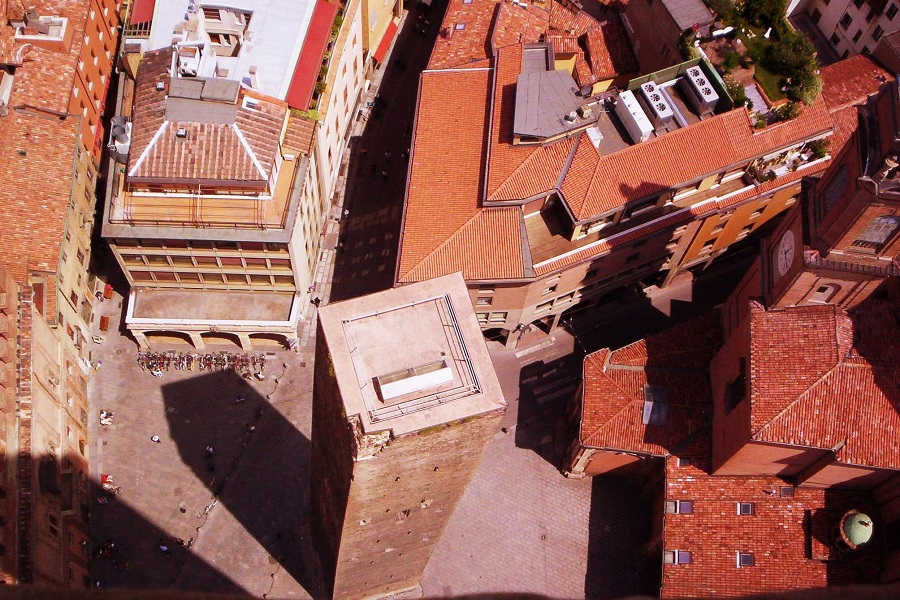
Garisenda Tower in Bologna city centre (Photo: debbyr via Wikimedia / CC BY-SA)
Stretching nearly from coast to coast, Emilia-Romagna lies at the heart of northern Italy. Its many art cities are spread evenly across the region, making it easy to hop from one to the other. In between them, both lowland and mountain landscapes are dotted with historic landmarks and ancient villages, while the Riviera Romagnola takes centre stage in summer. Notoriously warm local hospitality adds to the allure, serving as a much fitting complement to one of Italy’s most celebrated regional cuisines.
The Castles of Parma and Piacenza
The region near Parma and Piacenza is dotted with historic landmarks which make it ideal for a castle-hopping tour. Located in close proximity to one other, over thirty fortresses, strongholds and manor houses provide many opportunities to delve into art and history, with a focus on the independent duchy that once ruled over these territories. Romantic accommodations, guided tours and elegant gardens are some of the options available to experience the legacy of the duchy, while the culinary offering includes medieval-themed banquets.
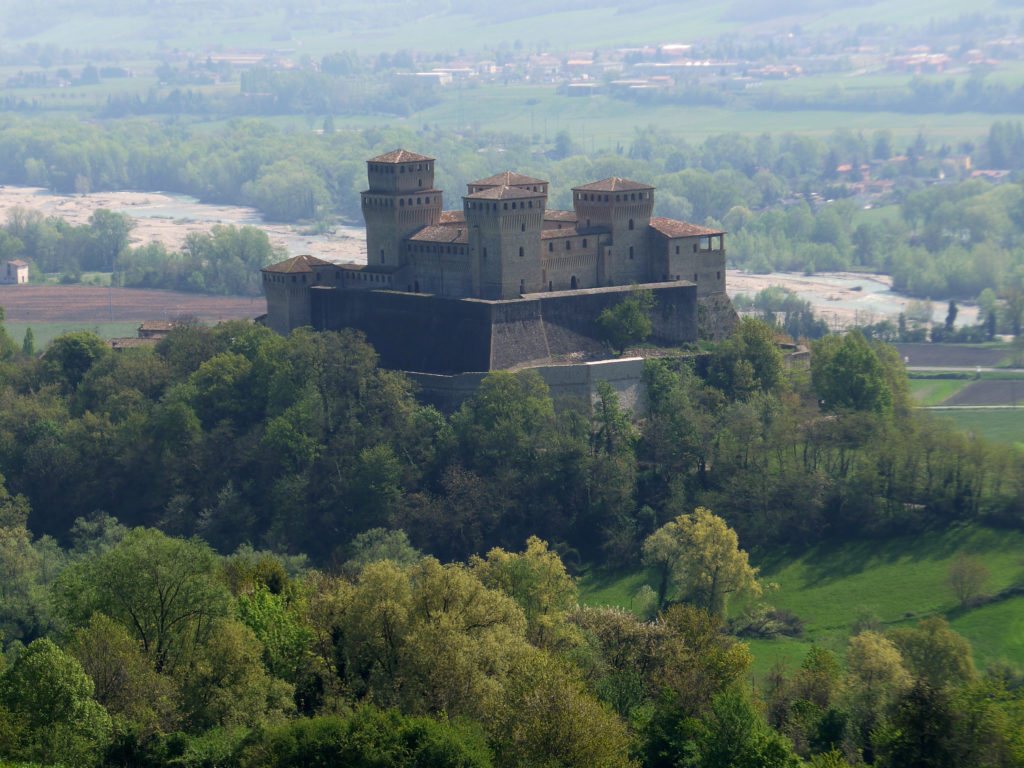
Torrechiara is one of 14 castles in the Parma region (Photo: Massimo Telo via Wikimedia / CC BY-SA)
Italy’s food valley
Food lovers will be quick to link the cities of the ‘food valley’ to world-famous culinary delights. To name but three, Parma Ham, Modena Traditional Balsamic Vinegar, and Parmigiano Reggiano are all from this region. A guided tour inclusive of a tasting session is the best way to go back to the roots of these ambassadors of Italian cuisine, and learn about the techniques and culture behind their production. The local trattorie of cities like Parma, Modena and Reggio nell’Emilia are also places of discovery, where the journey is likely to extend well beyond the classics.
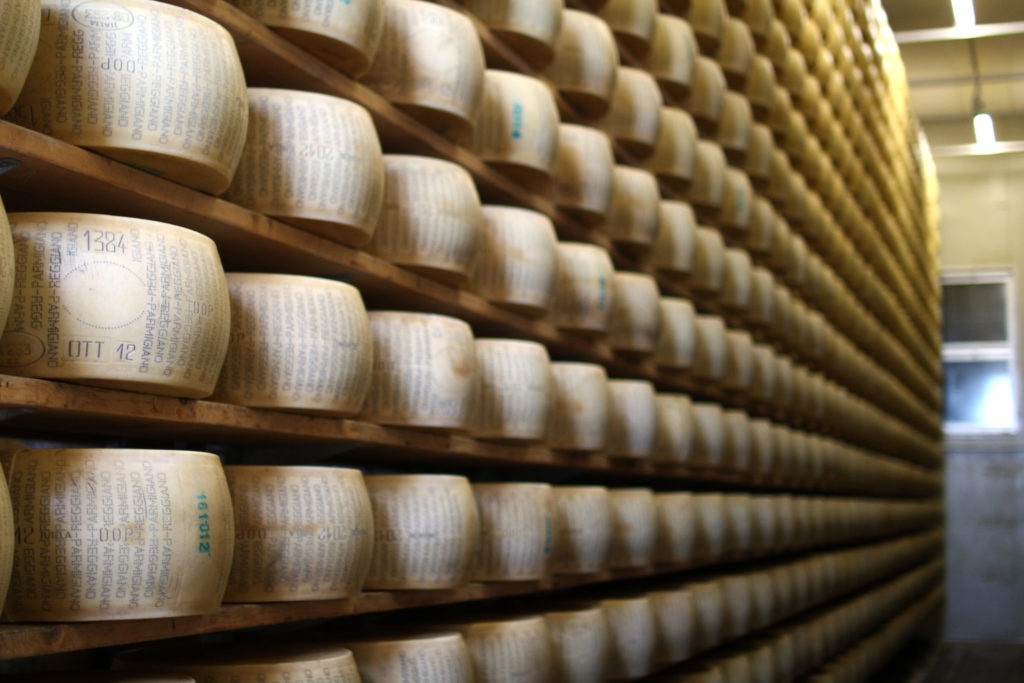
A Parmigiano Reggiano factory (Photo: Matt Lewis via Flickr / CC BY-SA 2.0)
The city centre of Bologna
The defining traits of the capital of Emilia-Romagna are also her nicknames: ‘Red’, ‘Cultured’ and ‘Fat’. Red bricks and distinctive porticoes set the tone of the historic centre, whose medieval roots show in architectural gems such as the city’s own leaning tower (Torre degli Asinelli). The university is famously the oldest in Europe, attracting crowds of students which pair well with the local cultural vibrancy. Tortellini-packed deli counters and freshly-sliced mortadella explain what sort of delicacies feed into the third nickname.
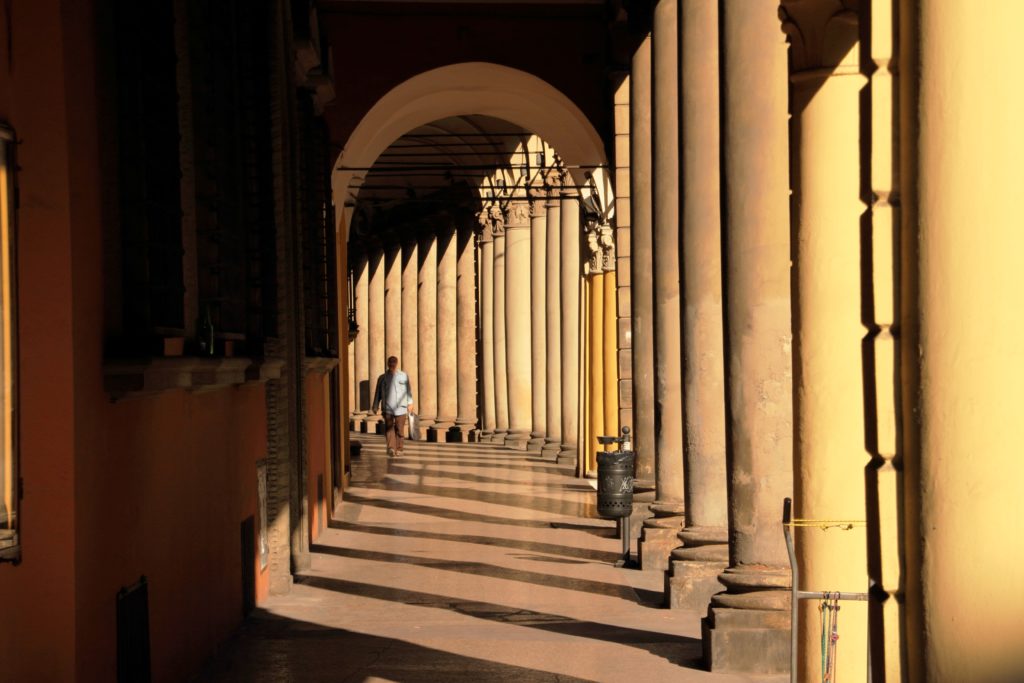
The porticoes of Bologna (Photo: Giovanni Osbat via Wikimedia / CC BY-SA)
Po Delta Park
Italy’s main river, the Po empties into the Adriatic Sea near Ravenna and Ferrara. Its delta is part of a protected area stretching across 130,000 acres, formed by an exceptional diversity of natural environments. Wetlands and pinewoods are cut through by the park’s itineraries, while a great variety of fish populates fresh and brackish waters. The natural treasures coexist peacefully with man-made attractions such as the charming bridges and canalside houses of Comacchio, making this area a must-see for outdoor lovers visiting Emilia-Romagna.
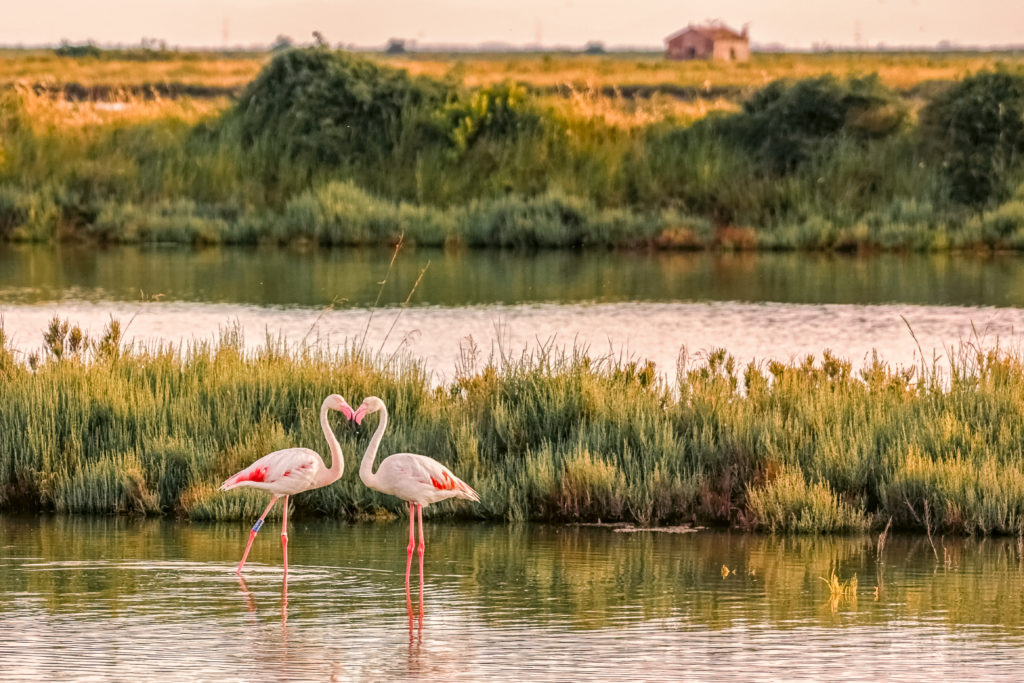
The Comacchio valley (Photo: Francesco 1978 via Wikimedia / CC BY-SA)
The mosaics of Ravenna
The early-Christian churches of Ravenna are home to unparalleled mosaic art from the 5th and 6th centuries. Such splendour reflects the important role the city played at the time, first as capital of the Western Roman Empire and then seat of Byzantine Italy. Seven of its eight UNESCO-listed sites are decorated with masterfully-crafted religious scenes, where Graeco-Roman art meets Byzantine style. The tour of the mosaics includes lesser-known sites too, such as the underwater floor at San Francesco Basilica. Many workshops scattered around Ravenna city centre keep alive this traditional craft.
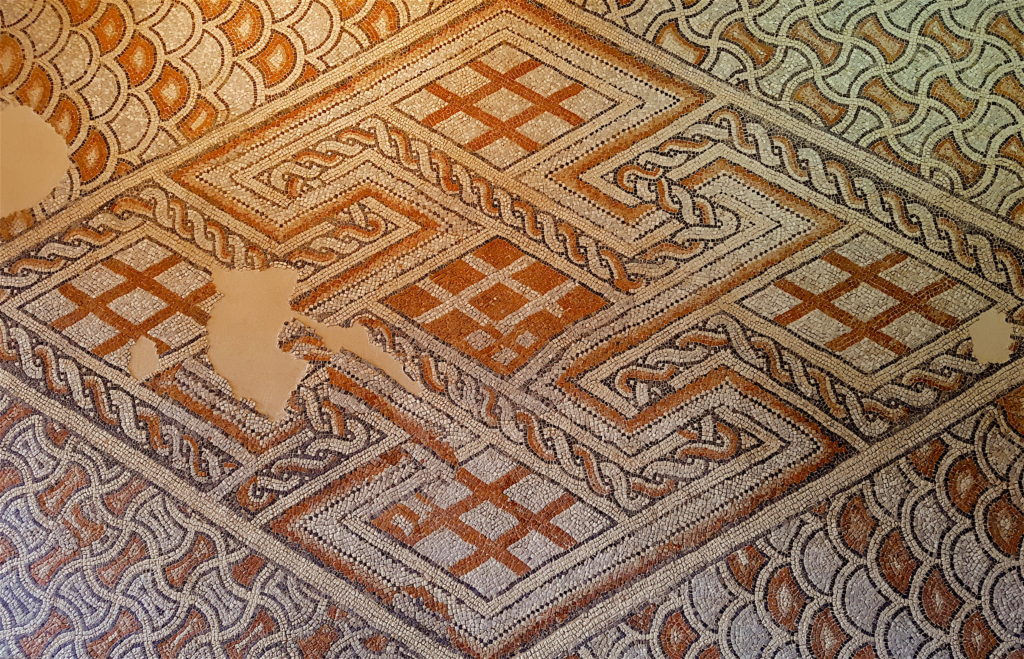
Teodorico Palace in Ravenna (Photo: opi1010 via Wikimedia / CC BY-SA)
Rimini and the places of Federico Fellini
Sandy beaches, nightlife and amusement parks have long made Rimini a widely popular resort on the Adriatic coast. Every year, crowds of holidaymakers flock to the Riviera Romagnola to enjoy its quintessential summer vibes, but there is much more to discover away from the shade of beach umbrellas. Roman and medieval landmarks shape the historic centre, while the castle-topped villages of the hinterland call for a trip out of town. Another way to experience the city is through the eyes of Federico Fellini, starting from the brand-new museum celebrating the 100th anniversary of his birth. The director of ‘La Dolce Vita’ left for Rome aged 19 but never stopped finding inspiration in his hometown, and many references to his films can be hunted down while walking around Rimini.
The Fellini Museum is set to open at Sismondo Castle between December 2020 and January 2021
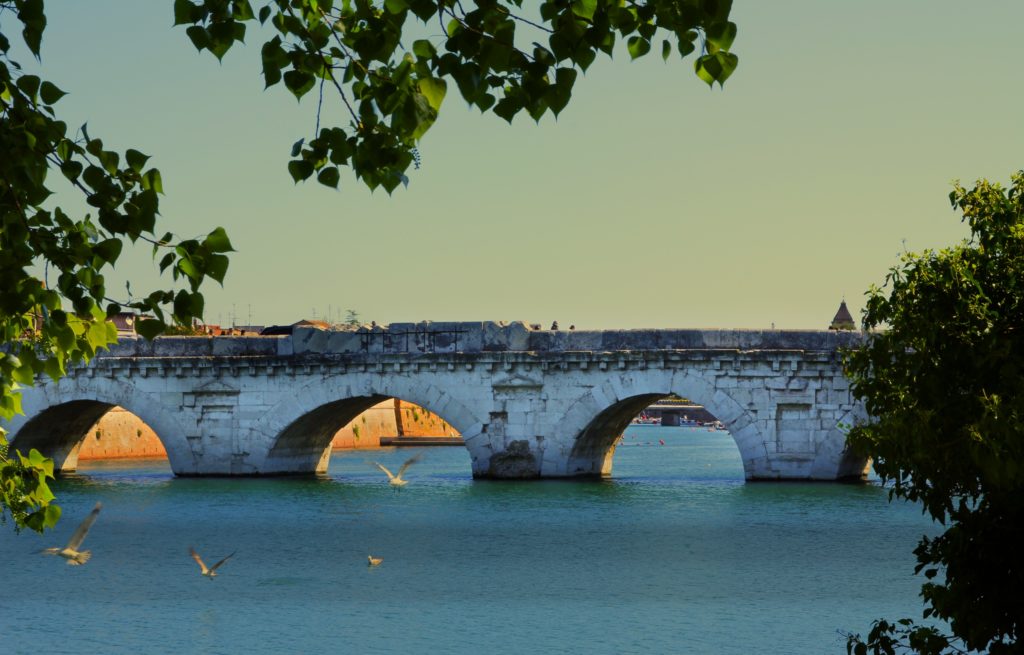
The Bridge of Tiberius, Rimini (Photo: Scorpione 68 via Wikimedia / CC BY-SA)
The Motor Valley
Much like a spread-out theme park, the Motor Valley offers a range of attractions celebrating the region’s passion for thrill, style and mechanics. This is the Italian epicentre when it comes to cars and motorbikes, home to great manufacturers such as Ferrari, Lamborghini, Ducati and Pagani. Thirteen museums and 18 collections tell stories which often blur into legend, likely to entice keen motorists and casual visitors alike. Hands-on-the-wheel experiences on world-famous race tracks are also available, as well as sport events and visits to the manufacturing plants.
The City of the Renaissance
The Estense Castle alone would be worth a visit to Ferrara. Surrounded by its moat, the former residence of the Este dynasty testifies to the cultural and political advancement the city reached as an independent duchy, between the 15th and the 16th centuries. So do many other palaces scattered across the city centre, which earned Ferrara the title of ‘City of the Renaissance’ on the UNESCO World Heritage List. Palazzo Diamanti, Palazzo Schifanonia and the house of epic poet Ludovico Ariosto are only some of the landmarks not to be missed during the visit.
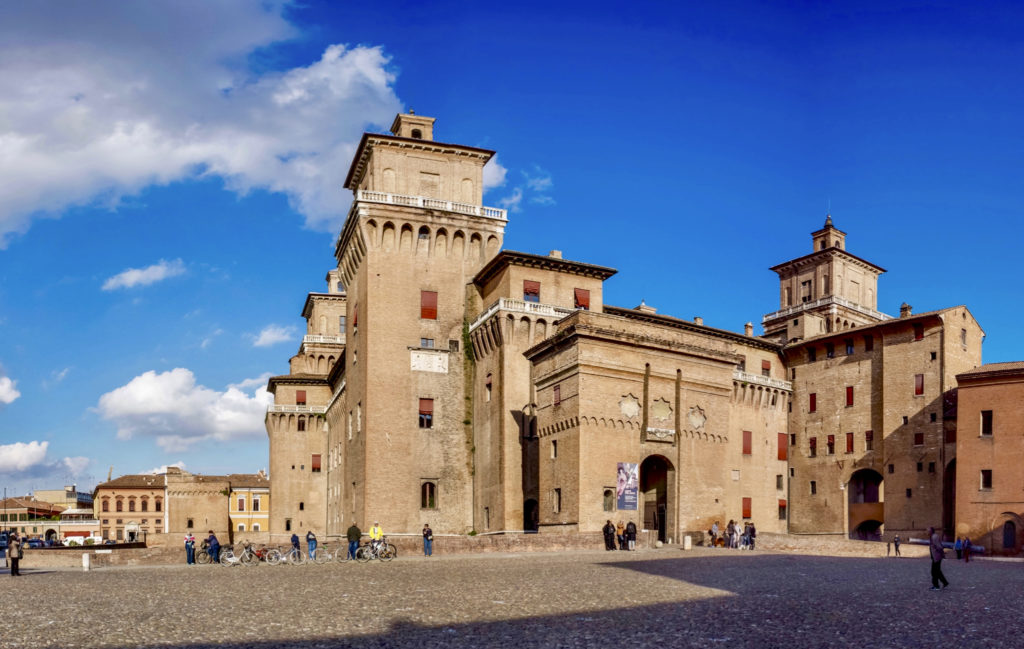
The Estense Castle (Photo: Vanni Lazzari via Wikimedia / CC BY-SA)
Casa Artusi
A museum, library, restaurant, wine cellar and cookery school, Casa Artusi is ultimately an all-round sanctuary devoted to food culture. It is named after Pellegrino Artusi, who in 1891 published a pioneering cookbook based on his own experiments and culinary travels. Much like the 790 recipes included in ‘Science in the Kitchen and the Art of Eating Well’, the museum promotes conviviality, culture, tradition and creativity, offering a range of experiences right at the roots of modern Italian home cooking. It is located in Artusi’s hometown Forlimpopoli, which also honours him with a food festival every summer.
Via A. Costa 23/27, 47034 Forlimpopoli (FC)
The Wellness Valley at Bagno di Romagna
Bagno di Romagna has been a renowned thermal town since Roman times. Its therapeutic waters are ideal for a relaxing stay focused on wellbeing and slow living, surrounded by the Casentinesi Forests National Park. The outdoor attractions include mountain lakes and a gnome village for the youngest visitors, while winter days can be spent looking at snowy slopes from the comfort of a 47-degree heated pool. Palazzo del Capitano and a 9th-century basilica are the town’s highlights for art and history lovers. Some of the accommodation options are part of Wellness Valley, a project dedicated to wellbeing and slow tourism in the Romagna region.
The Ancient Malatestiana Library
Along with ancient texts and manuscripts, the Malatestiana Library conserves the exact structure it had when it opened in 1454, just before the coming of the printing press. No other monastic library from the Renaissance has reached our day in its original form, stowing exceptional records of humanist culture for over 500 years. It was also the first public library in Italy, even though entrusted to the care of Franciscan friars. Located in the city centre of Cesena, the old wings of the library include original décor and furnishings, while ancient books are displayed on rotation.
Guided tours only. Booking requests to prenotazioni@comune.cesena.fc.it
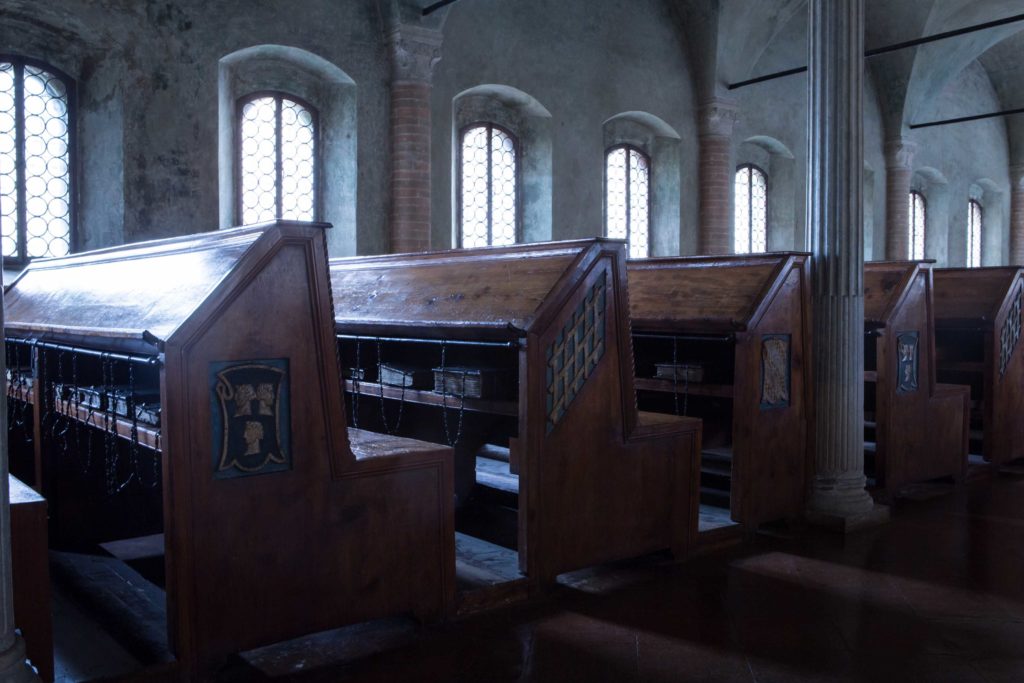
Ancient texts at Malatesitana Library (Photo: marco65 via Wikimedia / CC BY-SA)
Matilde’s Way
Many hiking routes cross the mountains and plains of Emilia-Romagna. Away from busy roads and crowded cities, visitors treading these paths follow in the footsteps of ancient pilgrims, discovering the region’s outdoors through the lenses of history and spirituality. Matilde’s Way ventures into the territories once controlled by Matilde di Canossa, one of the most prominent figures in Italian medieval history. Going back nearly a thousand years, her story echoes across the castles, monasteries and ancient hamlets found along the path.
Dante’s Path
Exiled from his hometown Florence in 1302, Dante Alighieri wandered across northern Italy for the rest of his life and eventually reached Ravenna, his resting place. This circular trail follows his journey backwards from the sepulchre to the birthplace, then back again along a different route. Visitors tread ancient paths while discovering the towns and landscapes which inspired the Divine Comedy, written during the exile years. A culture-filled hike in the footsteps of the Sommo Poeta. The whole route (around 400 km in total) is formed by 21 sections and planning ahead is recommended.
Way of the Gods
This route linking Bologna to Florence was first trodden by the Etruscans between the 7th and the 4th centuries BC. Later, the Romans laid new pavement to make it a strategic passage through the Appennines, sections of which are still visible along the way. Recently restored, the path has been named after some of the locations it goes past, such as Mount Venus and Mount Adonis. Many other landmarks punctuate the trail, providing a surprising overview of the region’s nature, history and gastronomy. The trek is suitable for all, taking four to six days to be completed in full (two to three by bike).
More information about each trail at camminiemiliaromagna.it/en
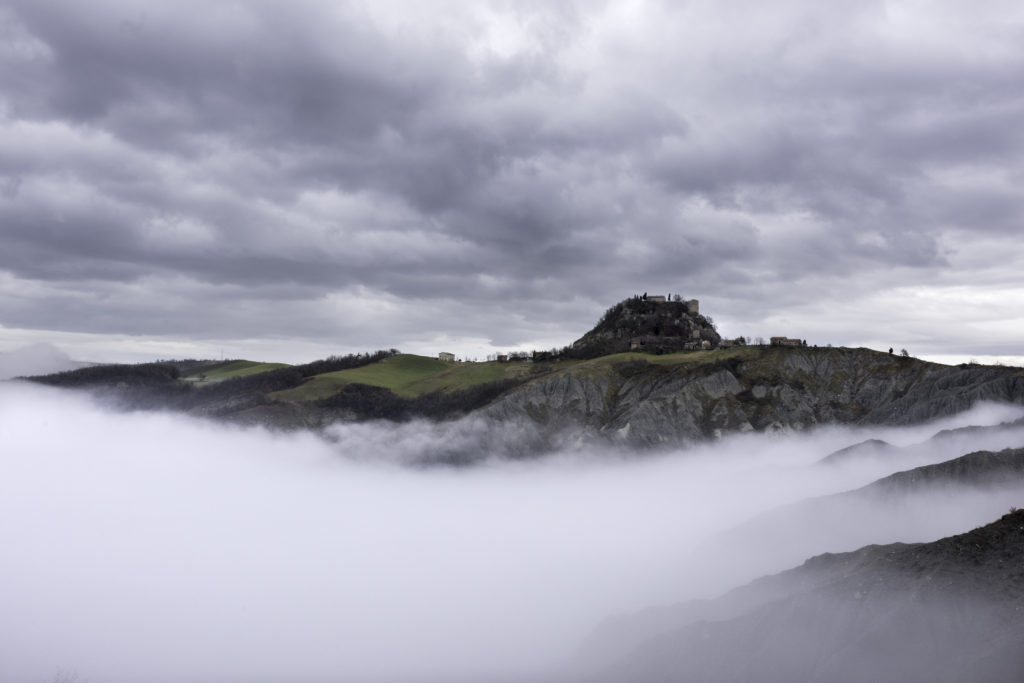
The Castle of Canossa along Matilde’s Way (Photo: marcocattani via Wikimedia / CC BY-SA)
Parma and its monasteries
Sharing its name with a famous novel by Stendhal, the Certosa di Parma is often mistaken for the French writer’s source of inspiration. The many changes this former monastery has gone through since its foundation (1285) have left untouched parts of the original structure, as well as rich frescoes and Renaissance embellishments. The actual monastery believed to have inspired Stendhal is however the Abbey of Valserena, sitting just a few kilometres north. Both sites are worthy detours while visiting Parma, Italian Capital of Culture 2020-21. Starting from the Romanesque Piazza del Duomo, the tour includes several churches and historic landmarks, but the excellent local gastronomy is likely to claim all the attention along the way.
Labirinto della Masone
This cultural park is home to an intriguing labyrinth formed by around 200,000 bamboo plants varying in height and species. It combines elements of classic Roman mazes with Neoclassical architecture and an elegant eight-angled perimeter, where a three-km path sneaks around traps and dead ends. Publisher and designer Franco Maria Ricci launched this project in 2015, many years after discussing it with Argentinian writer Jorge Luis Borges. Claimed to house the world’s largest maze of its kind, the park also includes an art collection, two restaurants and a café. Two suites are available to spend the night at the park.
Strada Masone 121, 43012 Fontanellato (PR)
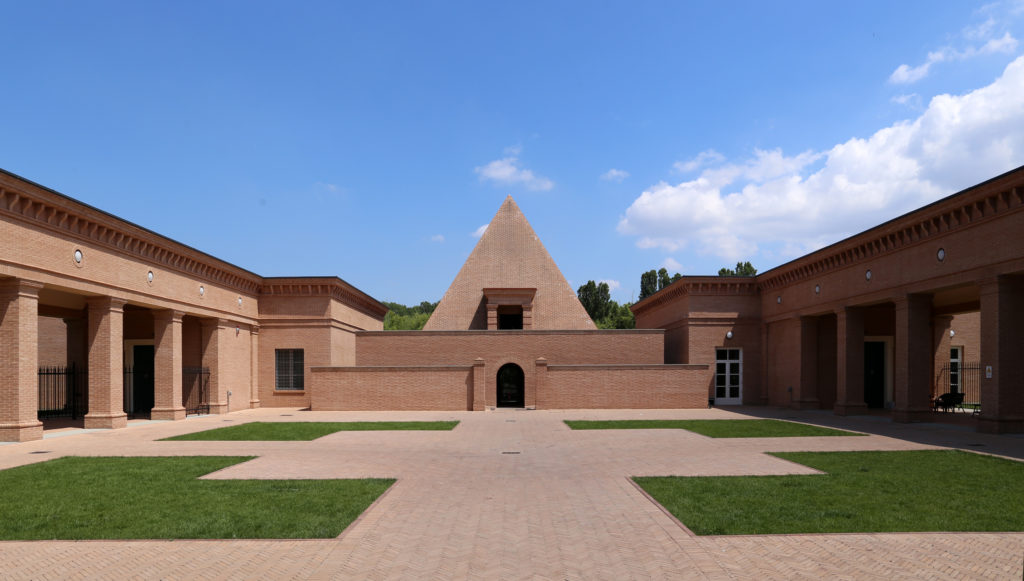
Neoclassical Utopian architecture within the labyrinth (Photo: sailko via Wikimedia / Cc BY-SA 3.0)
The cathedral of Modena
Along with Piazza Grande and the Ghirlandina Tower, the cathedral of Modena is another UNESCO site of Emilia-Romagna. This 12th-century example of Romanesque art is striking both for its architecture and sculptures, attributed respectively to Lanfranco and Wiligelmo. Construction started in 1099 to host the tomb of Saint Geminianus, patron saint of Modena. Nearly a thousand years later, the cathedral still exhibits the artistic and religious fervour of the time, examples of which are also found elsewhere across the city. Another must-see while touring the area is the Nonantola Abbey, ten kilometres east of the city centre.
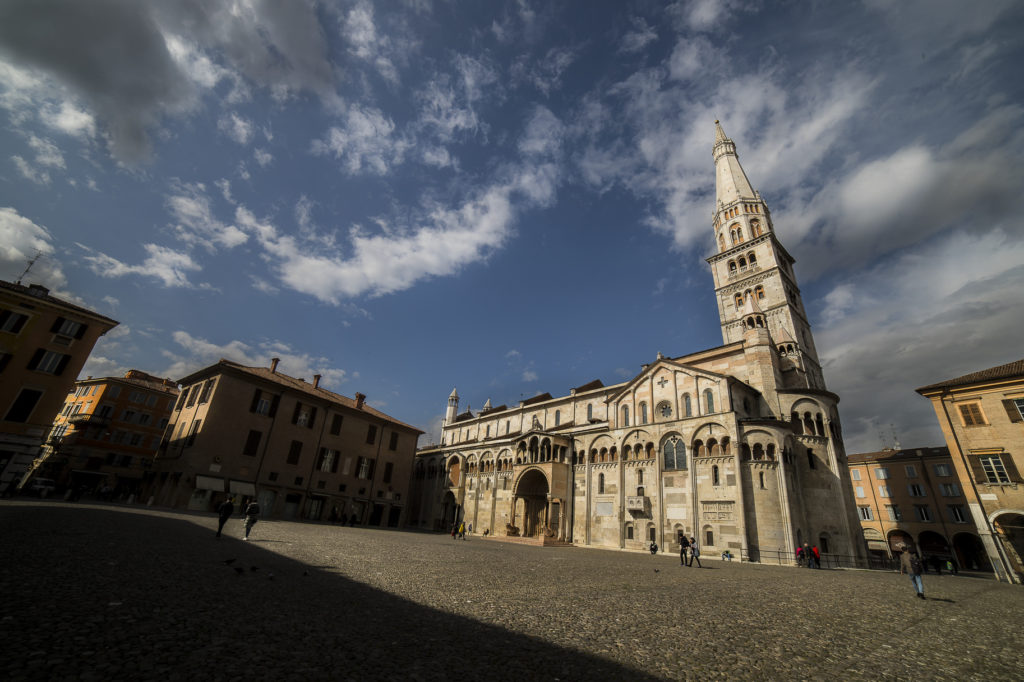
Ghirlandina Tower by the cathedral of Modena (Photo: Angelo Nastri via Wikimedia / CC BY-SA)
Bobbio and the Trebbia Valley
The small town of Bobbio used to be one of the most influential monastic centres in Europe, home to a renowned scriptorium and library dating back to the 7th century. Its medieval heritage includes Saint Columbanus Abbey, the ancient ‘Hunched’ Bridge, and the Malaspina Castle, where an open view encourages further exploration into the Trebbia Valley. Travelling here as a war reporter in 1945, Ernest Hemingway is claimed to have named this ‘the world’s most beautiful valley’, and the lack of solid evidence to his comment is made up for by shifting sceneries hiding behind each meander of the river. A most spectacular view can be enjoyed from the stone hamlet of Brugnello, perched on a cliff ten kilometres south of Bobbio.
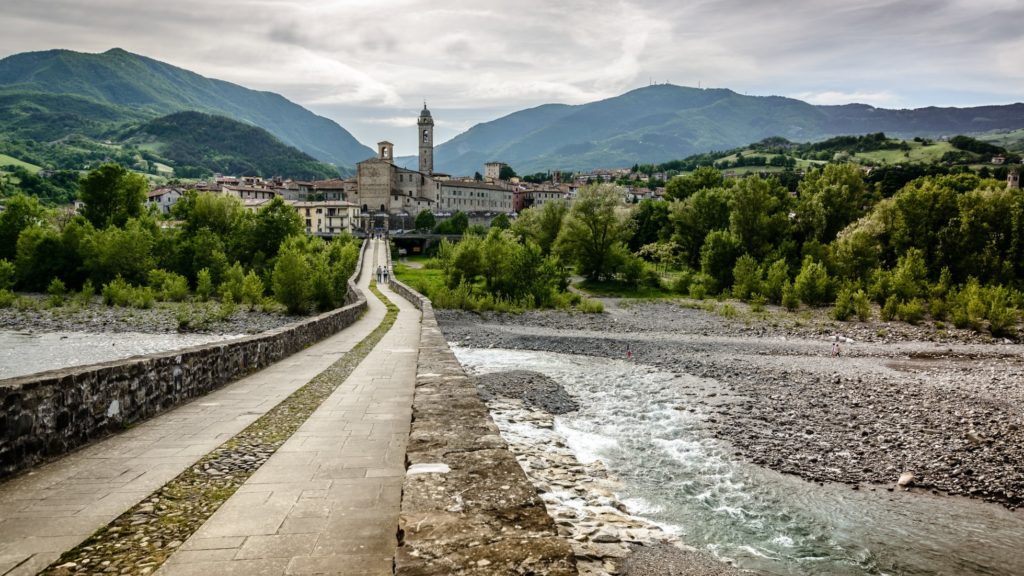
The ancient bridge of Bobbio, aka the Devil’s Bridge (Photo: Matteo Russo via Flickr / CC BY-SA 2.0)
The Apennines’ natural parks
Separating the Tuscan coast from the inland plains of Emilia-Romagna, the Appennines are home to a rich diversity of landscapes and environments. Two national parks stretch across this mountain range, both conveniently located within easy reach of large cities such as Milan, Florence, Bologna and Genoa. The Tuscan-Emilian Apennines park includes the glacial Santo Lake and the Stone of Bismantova, a distinctively-shaped plateau likened by Dante to Mount Purgatory. Other spectacular sceneries such as the Acquacheta Falls are located further south along the Tuscan-Emilian border, within the area covered by the Casentinesi Forests park.
The cycling routes of Valmarecchia
Bike-friendly cities and smooth landscapes make Emilia-Romagna one of Italy’s top cycling destinations. From the Adriatic coast to the Apennines, the whole region is criss-crossed by major and more secluded trails, including some linked to the international network Eurovelo. The hinterland of Rimini, for example, provides plenty of opportunities for bike excursions. An easy and rewarding trail runs along the Marecchia River, while venturing up the slopes of the valley might be worth the effort to reach castle-topped villages such as Montebello, Petrella Guidi and Sant’Agata Feltria. Other destinations to look out for while touring the valley include Santarcangelo, Verucchio and Talamello.